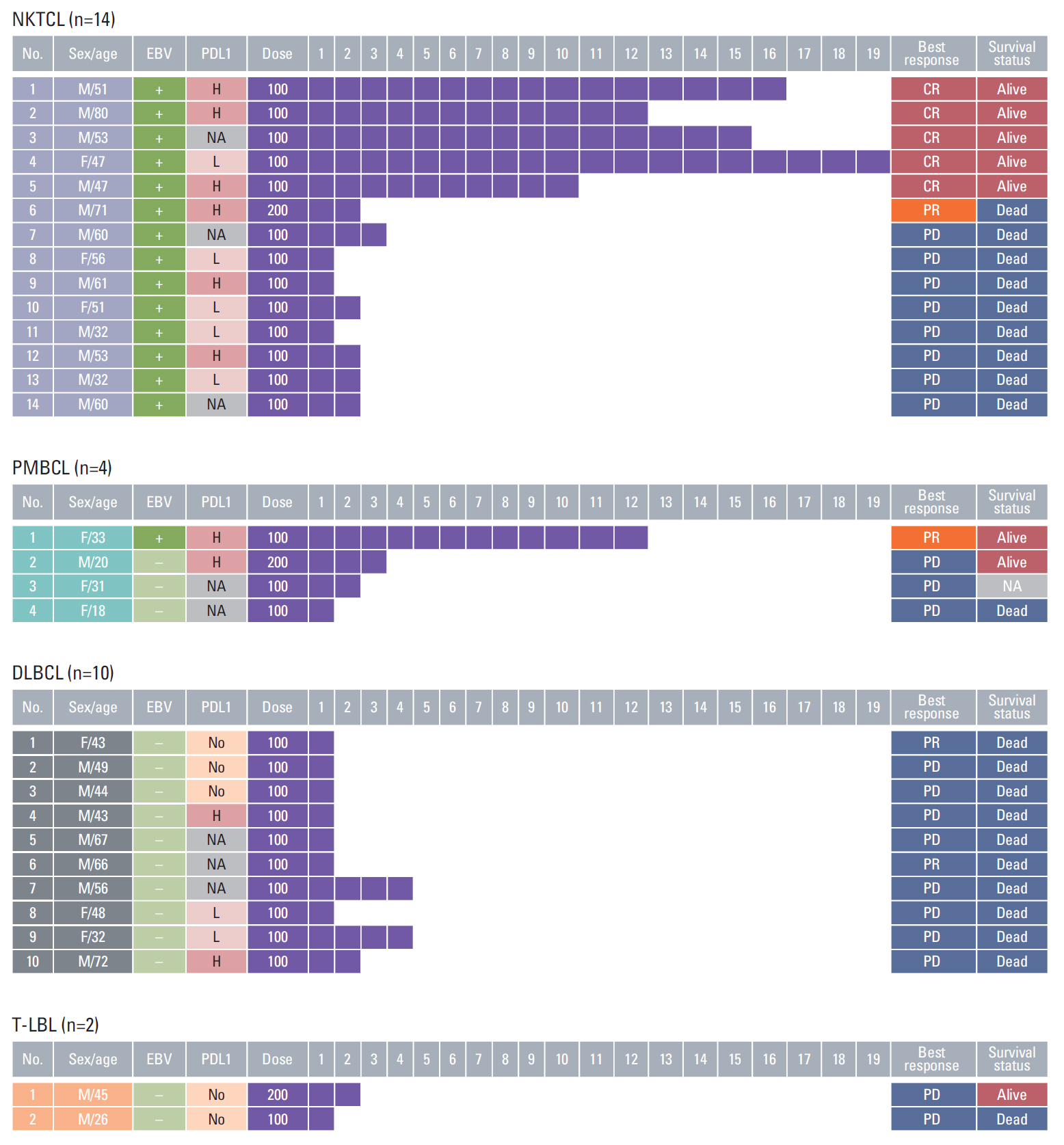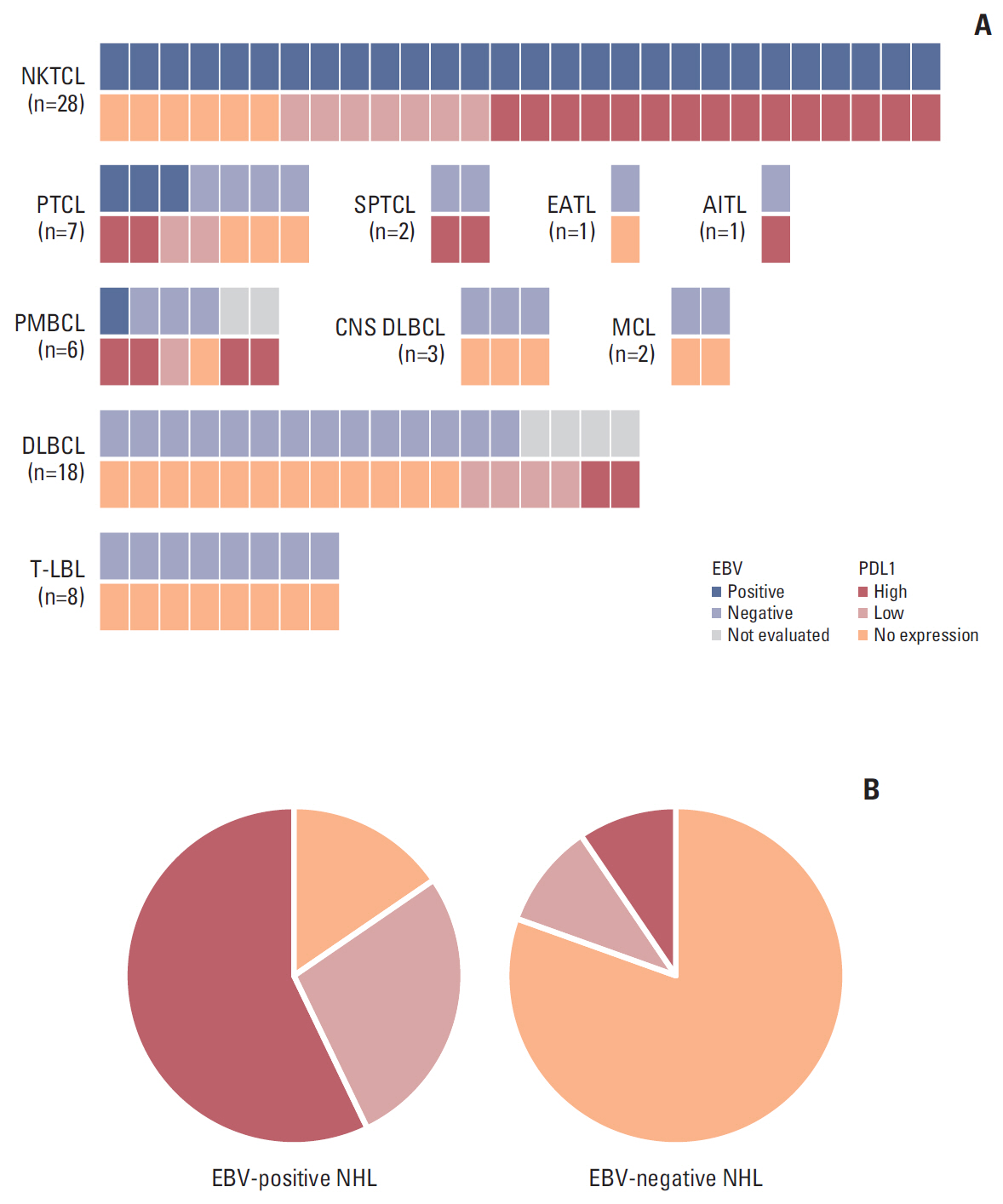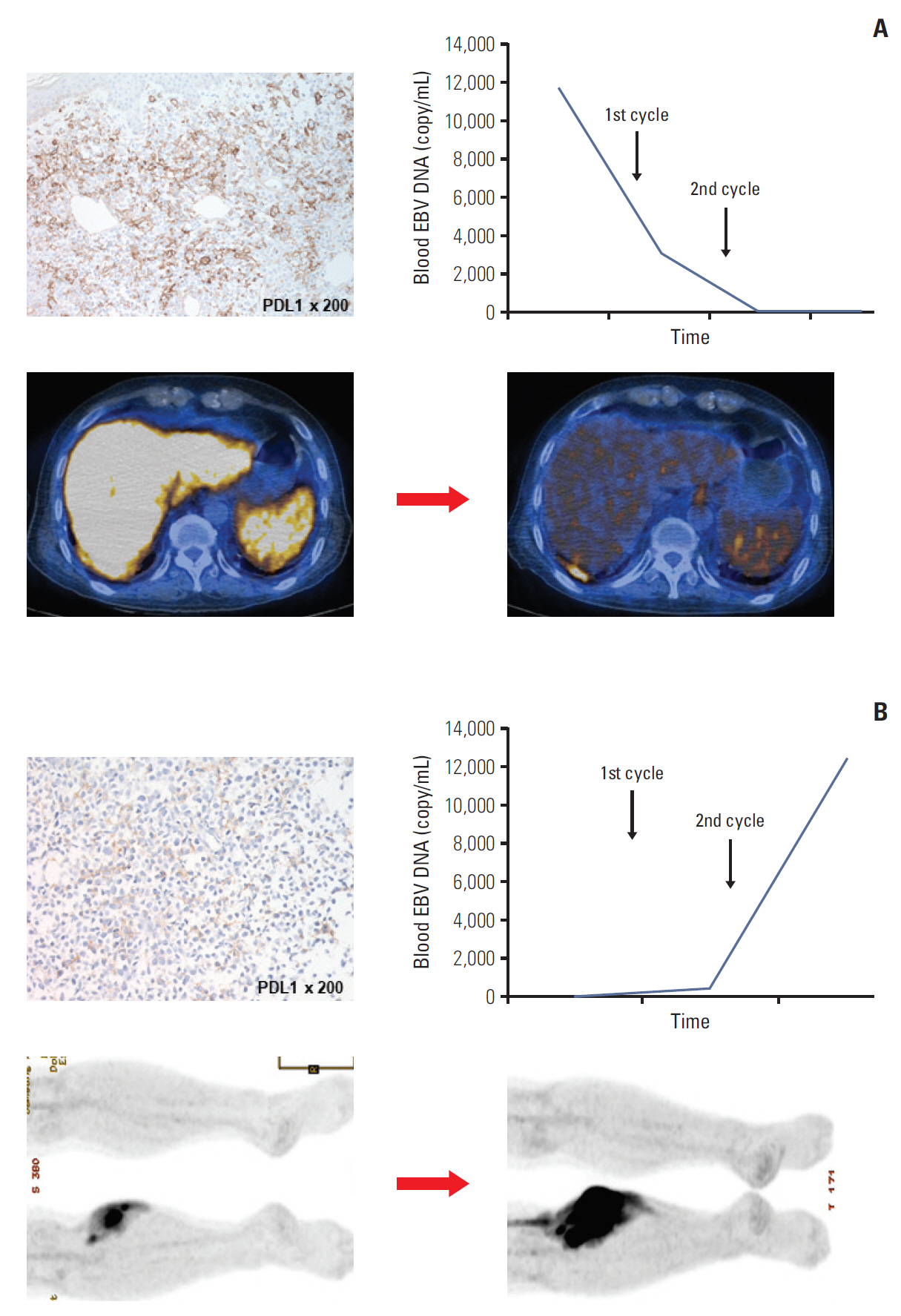Cancer Res Treat.
2019 Apr;51(2):611-622. 10.4143/crt.2018.191.
Comparison of Efficacy of Pembrolizumab between Epstein-Barr Virus‒Positive and ‒Negative Relapsed or Refractory Non-Hodgkin Lymphomas
- Affiliations
-
- 1Division of Hematology-Oncology, Department of Medicine, Samsung Medical Center, Sungkyunkwan University School of Medicine, Seoul, Korea. wskimsmc@skku.edu
- 2Department of Pathology, Samsung Medical Center, Sungkyunkwan University School of Medicine, Seoul, Korea.
- KMID: 2464408
- DOI: http://doi.org/10.4143/crt.2018.191
Abstract
- PURPOSE
Pembrolizumab, a programmed cell death protein 1 (PD1) inhibitor inhibits the interplay between PD1 of T-cell and programmed cell death ligand 1 (PDL1) on tumor cells. Although pembrolizumab has been tried to various subtypes of non-Hodgkin lymphoma (NHL), real-world data about the efficacy of pembrolizumab in NHL patients are limited.
MATERIALS AND METHODS
We analyzed the outcome of 30 relapsed or refractory NHL patients treated with pembrolizumab, and compared the outcome between Epstein-Barr virus (EBV)"’positive and negative subtypes because EBV infection of tumor cells can upregulate PDL1 expression.
RESULTS
Seven patients with EBV-positive NHL showed a response including NK/T-cell lymphoma (6/14, 44%) and primary mediastinal B-cell lymphoma (1/4, 25%) whereas EBV-negative subtypes did not respond such as diffuse large B-cell lymphoma and T-lymphoblastic lymphoma. We also evaluated PDL1 expression using tumor tissue of 76 patients. High PDL1 expression (positive staining of > 50% of tumor cells) was more frequent in NK/T-cell lymphoma and primary mediastinal B-cell lymphoma than other subtypes. Thus, PDL1 expression was significantly higher in EBV-positive (18/32, 56%) than EBV-negative NHL (4/38, 11%, p < 0.001). Furthermore, NK/T-cell lymphoma patients with high PDL1 expression showed a higher response (4/6, 67%) than those with low PDL1 expression (1/5, 20%).
CONCLUSION
Pembrolizumab could be useful as a salvage treatment for relapsed or refractory EBV-positive NHL, especially NK/T-cell lymphoma. However, its efficacy in EBV-negative NHL with low or absent PDL1 expression is still not clear although pembrolizumab could be a potential treatment option for relapsed or refractory NHL.
Keyword
MeSH Terms
Figure
Cited by 2 articles
-
Pembrolizumab for Patients with Relapsed or Refractory Extranodal NK/T-Cell Lymphoma in Korea
Ji Yun Lee, Ji Hyun Kwon, Joon Young Hur, Jun Ho Yi, Ji Hyun Lee, Hyungwoo Cho, Young Rok Do, Jae-Cheol Jo, Hye Jin Kang, Yougil Koh, Won Sik Lee, Sung Nam Lim, Sang Eun Yoon, Seok Jin Kim, Jeong-Ok Lee
Cancer Res Treat. 2024;56(2):681-687. doi: 10.4143/crt.2023.1042.PD-1 inhibitors plus chemotherapy for refractory EBV-positive DLBCL: a retrospective analysis
Youli Li, Yonghe Wu, Sufen Cao, Baohua Yu, Qunling Zhang, Zuguang Xia, Junning Cao, Fangfang Lv, Guang‑Liang Chen
Blood Res. 2024;59:36. doi: 10.1007/s44313-024-00042-6.
Reference
-
References
1. Mak V, Hamm J, Chhanabhai M, Shenkier T, Klasa R, Sehn LH, et al. Survival of patients with peripheral T-cell lymphoma after first relapse or progression: spectrum of disease and rare long-term survivors. J Clin Oncol. 2013; 31:1970–6.
Article2. Crump M, Neelapu SS, Farooq U, Van Den Neste E, Kuruvilla J, Westin J, et al. Outcomes in refractory diffuse large B-cell lymphoma: results from the international SCHOLAR-1 study. Blood. 2017; 130:1800–8.
Article3. Weber J. Immune checkpoint proteins: a new therapeutic paradigm for cancer--preclinical background: CTLA-4 and PD-1 blockade. Semin Oncol. 2010; 37:430–9.
Article4. Chen L, Flies DB. Molecular mechanisms of T cell co-stimulation and co-inhibition. Nat Rev Immunol. 2013; 13:227–42.
Article5. Kwong YL, Chan TS, Tan D, Kim SJ, Poon LM, Mow B, et al. PD1 blockade with pembrolizumab is highly effective in relapsed or refractory NK/T-cell lymphoma failing l-asparaginase. Blood. 2017; 129:2437–42.
Article6. Cheson BD, Fisher RI, Barrington SF, Cavalli F, Schwartz LH, Zucca E, et al. Recommendations for initial evaluation, staging, and response assessment of Hodgkin and non-Hodgkin lymphoma: the Lugano classification. J Clin Oncol. 2014; 32:3059–68.
Article7. Kim SJ, Choi JY, Hyun SH, Ki CS, Oh D, Ahn YC, et al. Risk stratification on the basis of Deauville score on PET-CT and the presence of Epstein-Barr virus DNA after completion of primary treatment for extranodal natural killer/T-cell lymphoma, nasal type: a multicentre, retrospective analysis. Lancet Haematol. 2015; 2:e66–74.8. Dako North America. PD-L1 IHC 22C3 pharmDx (package insert). Carpinteria, CA: Dako North America;2015.9. Lai J, Xu P, Jiang X, Zhou S, Liu A. Successful treatment with anti-programmed-death-1 antibody in a relapsed natural killer/T-cell lymphoma patient with multi-line resistance: a case report. BMC Cancer. 2017; 17:507.
Article10. Chan TS, Khong PL, Kwong YL. Pembrolizumab for relapsed anaplastic large cell lymphoma after allogeneic haematopoietic stem cell transplantation: efficacy and safety. Ann Hematol. 2016; 95:1913–5.
Article11. Zinzani PL, Ribrag V, Moskowitz CH, Michot JM, Kuruvilla J, Balakumaran A, et al. Safety and tolerability of pembrolizumab in patients with relapsed/refractory primary mediastinal large B-cell lymphoma. Blood. 2017; 130:267–70.
Article12. Nastoupil LJ, Westin J, Fowler N, Fanale M, Samaniego F, Oki Y, et al. High response rates with pembrolizumab in combination with rituximab in patients with relapsed follicular lymphoma: interim results of an on open-label, phase II study. Hematol Oncol. 2017; 35(Suppl 2):120–1.
Article13. Chan TS, Khong PL, Kwong YL. Pembrolizumab and lenalidomide induced remission in refractory double-hit lymphoma. Ann Hematol. 2016; 95:1917–8.
Article14. Menter T, Bodmer-Haecki A, Dirnhofer S, Tzankov A. Evaluation of the diagnostic and prognostic value of PDL1 expression in Hodgkin and B-cell lymphomas. Hum Pathol. 2016; 54:17–24.
Article15. Vranic S, Ghosh N, Kimbrough J, Bilalovic N, Bender R, Arguello D, et al. PD-L1 status in refractory lymphomas. PLoS One. 2016; 11:e0166266.
Article16. Kiyasu J, Miyoshi H, Hirata A, Arakawa F, Ichikawa A, Niino D, et al. Expression of programmed cell death ligand 1 is associated with poor overall survival in patients with diffuse large B-cell lymphoma. Blood. 2015; 126:2193–201.
Article17. Roemer MG, Advani RH, Ligon AH, Natkunam Y, Redd RA, Homer H, et al. PD-L1 and PD-L2 genetic alterations define classical Hodgkin lymphoma and predict outcome. J Clin Oncol. 2016; 34:2690–7.
Article18. Twa DD, Chan FC, Ben-Neriah S, Woolcock BW, Mottok A, Tan KL, et al. Genomic rearrangements involving programmed death ligands are recurrent in primary mediastinal large B-cell lymphoma. Blood. 2014; 123:2062–5.
Article19. Chapuy B, Roemer MG, Stewart C, Tan Y, Abo RP, Zhang L, et al. Targetable genetic features of primary testicular and primary central nervous system lymphomas. Blood. 2016; 127:869–81.
Article20. Four M, Cacheux V, Tempier A, Platero D, Fabbro M, Marin G, et al. PD1 and PDL1 expression in primary central nervous system diffuse large B-cell lymphoma are frequent and expression of PD1 predicts poor survival. Hematol Oncol. 2017; 35:487–96.
Article21. Jo JC, Kim M, Choi Y, Kim HJ, Kim JE, Chae SW, et al. Expression of programmed cell death 1 and programmed cell death ligand 1 in extranodal NK/T-cell lymphoma, nasal type. Ann Hematol. 2017; 96:25–31.
Article22. Kim WY, Jung HY, Nam SJ, Kim TM, Heo DS, Kim CW, et al. Expression of programmed cell death ligand 1 (PD-L1) in advanced stage EBV-associated extranodal NK/T cell lymphoma is associated with better prognosis. Virchows Arch. 2016; 469:581–90.
Article23. Ding W, LaPlant BR, Call TG, Parikh SA, Leis JF, He R, et al. Pembrolizumab in patients with CLL and Richter transformation or with relapsed CLL. Blood. 2017; 129:3419–27.
Article24. Chen BJ, Chapuy B, Ouyang J, Sun HH, Roemer MG, Xu ML, et al. PD-L1 expression is characteristic of a subset of aggressive B-cell lymphomas and virus-associated malignancies. Clin Cancer Res. 2013; 19:3462–73.
Article25. Roach C, Zhang N, Corigliano E, Jansson M, Toland G, Ponto G, et al. Development of a companion diagnostic PD-L1 immunohistochemistry assay for pembrolizumab therapy in non-small-cell lung cancer. Appl Immunohistochem Mol Morphol. 2016; 24:392–7.
Article26. Reck M, Rodriguez-Abreu D, Robinson AG, Hui R, Csoszi T, Fulop A, et al. Pembrolizumab versus chemotherapy for PD-L1-positive non-small-cell lung cancer. N Engl J Med. 2016; 375:1823–33.
Article27. Cheson BD, Ansell S, Schwartz L, Gordon LI, Advani R, Jacene HA, et al. Refinement of the Lugano Classification lymphoma response criteria in the era of immunomodulatory therapy. Blood. 2016; 128:2489–96.
Article28. Chan TS, Luk TH, Lau JS, Khong PL, Kwong YL. Low-dose pembrolizumab for relapsed/refractory Hodgkin lymphoma: high efficacy with minimal toxicity. Ann Hematol. 2017; 96:647–51.
Article29. Armand P, Shipp MA, Ribrag V, Michot JM, Zinzani PL, Kuruvilla J, et al. Programmed death-1 blockade with pembrolizumab in patients with classical Hodgkin lymphoma after brentuximab vedotin failure. J Clin Oncol. 2016; 34:3733–9.
Article30. Chen R, Zinzani PL, Fanale MA, Armand P, Johnson NA, Brice P, et al. Phase II study of the efficacy and safety of pembrolizumab for relapsed/refractory classic Hodgkin lymphoma. J Clin Oncol. 2017; 35:2125–32.
Article
- Full Text Links
- Actions
-
Cited
- CITED
-
- Close
- Share
- Similar articles
-
- The Incidence of Epstein-Barr Virus Nuclear Antigen in Sporadic Non-Hodgkin's Lymphomas of Korean
- Complete Remission after Pseudoprogression in Refractory Classical Hodgkin Lymphoma Treated with Pembrolizumab
- Detection and Subtyping of Epstein-Barr Virus in Gastrointestinal Adenocarcinomas and Malignant Lymphomas
- Epstein-Barr Virus in Korean Malignant Lymphomas
- The Incidence of the Epstein-Barr Virus Nuclear Antigen in Non-Hodgkin's Lymphomas of the Gastrointestinal Tract




